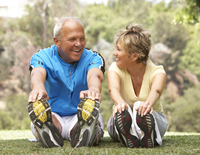By Matthew Ward
 According to the CDC, falls are the main cause of injury death in the over 65s and 20-30 per cent of people who fall suffer injuries ranging from fractures of the spine, forearm and hand, to lacerations and head traumas. Needless to say, the aging process makes our bodies’ less robust and more susceptible to bone fractures and bruising. Even the job of remaining safe in bed can become a difficult one, with the potential for falls to occur if proper precautions are not taken. Accordingly, to help Your Health Journal’s elderly and caregiver readers, we are going to look at some ways to prevent harm around the house.
According to the CDC, falls are the main cause of injury death in the over 65s and 20-30 per cent of people who fall suffer injuries ranging from fractures of the spine, forearm and hand, to lacerations and head traumas. Needless to say, the aging process makes our bodies’ less robust and more susceptible to bone fractures and bruising. Even the job of remaining safe in bed can become a difficult one, with the potential for falls to occur if proper precautions are not taken. Accordingly, to help Your Health Journal’s elderly and caregiver readers, we are going to look at some ways to prevent harm around the house.
Have a health check-up
It is important to take precautions – rather than waiting for something to go wrong – and the following should be reviewed on a regular basis:
• Medication: Certain prescriptions drugs can lead to drowsiness or dizziness, while elderly people who are currently on 3 or more medications are more likely to fall. Also be wary when combining them with allergy medications, alcohol or painkillers. Alternatives to medications which cause light-headedness include exercise, good nutrition and spinal manipulation.
• Mental health: Parkinson’s disease interferes with mobility and may lead to poor balance and impairment of decision making. It is therefore important to have regular check-ups for signs of mental health problems such as dementia.
• Health conditions: Other health issues which can lead to potentially harmful falls include low blood pressure, arthritis, diabetes and vitamin D deficiency.
Fix home hazards
Trip and fall hazards should be removed where possible. They tend to include loose carpets and wires, throw rugs and phone cords.
Assistive devices
There are assistive devices for the elderly and disabled which can be implemented around the house. These include grab bars, which can be used on stairways and in the bathroom; footstools to help make items easily reachable; trays for use in bed and around the house; specially made tap turners; and a range of bathing aids that include bath lifts, shower chairs and bath mats. But you must remember to take the time to understand what your requirements are and to get only appropriate assistive devices. Even placing night lights in the bedroom and hallways, and having a lamp next to your bed, can be effective.
Dangers in the bedroom
The bedroom and the bed itself can pose a dangerous prospect for elderly people in terms of potential falls, due to reduced mobility. Even getting comfortable to fall asleep can become a difficult task. And if mental health is a problem then this may lead to falls out of bed at night. In such cases, there are assistive bedroom devices specifically made for the elderly, including adjustable beds, bed-side rails and pillow lifts. There are also waterproof sheets and covers to aid seniors in the bedroom.
Exercise
As said earlier, prevention is often better than cure, which is where exercise proves so vital. To improve your strength, flexibility and balance, try some walking, swimming and tai chi, but only after you have received an okay to do so from your doctor.
Over to you
It is all well and good saying the types of things you can do to protect an elderly person in your house, but the changes you make will ultimately depend on your specific situation. The important thing is to involve seniors in any decision that are made and to take their particular mental and physical needs into account.
– This article was provided by Matthew Ward from Manage at Home where there is additional information on mobility aids for the elderly and disabled.
